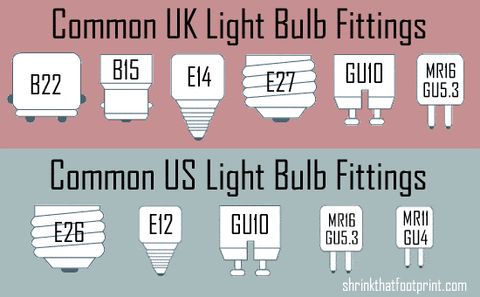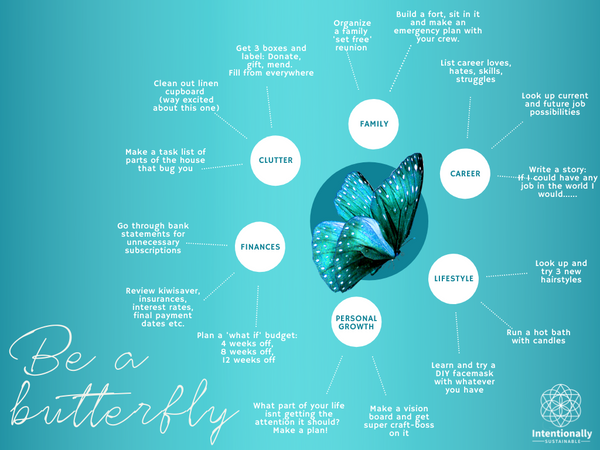It’s almost September and you might be thinking of preparing yourself for a detailed spring cleanup. Well, this time around you must try some sustainable products rather than using chemical ones to get the cleaning done.
There are a variety of options you can use to cut out the wasteful products from your buying list. Natural and repurposed cleaning products will not only help you reduce waste but will also prevent you from serious health issues.
Let’s take a look at what you can change in your cleaning routine to make it healthy and eco-friendly.

-
Avoid Using Paper Towels
Most of us use paper towels to clean almost everything in our home. These towels are made by cutting down trees, which adversely impacts our planet in the form of pollution and global warming. Therefore, it’s high time you ditch those paper towels and opt for eco-friendly alternatives. You can cut your old T-shirts into equal pieces and repurpose them for cleaning. Moreover, you can use cloth sponges to lift stains from your kitchen slabs and for washing dishes. Our Biodegradable Cellulose Printed Sponge Cloths are a great option to use in your kitchen as it is long-lasting, strong and easy to wash along with the quality of odor reduction. In this way, you can keep plenty of paper waste out of landfills.
-
Switch to Lemon for Metal Polish
You can eliminate the spots from your metal products and stainless steel kitchen utensils by using just lemon and salt. Half a lemon, smidge some salt or baking soda onto it and use it to polish your metal products. Cleanse the products and dry those with a cloth, your products will appear shiny as new. In order to make your steel bottles spotless from the inside, you can opt for Eco-friendly Glass and Bottle Scrub Brush.
-
Make DIY Air-Freshener
Air fresheners you often buy from the market contain harmful chemicals such as Volatile Organic Compounds (VOCs) that can deteriorate the indoor air quality along with your health. According to a report of the United States Environmental Protection Agency, exposure to VOCs can result in eyes, nose and throat irritation, nausea.. Thus, to avoid such problems you can make Stovetop Potpourri with natural ingredients at your home. For instance, mix apples, cinnamon and cloves in a water pot and let it boil. It will leave your home with a fresh aroma such that you will soon say goodbye to your usual air fresheners.
-
Ditch the Chemical Cleaning Agents
Vinegar is a non-toxic natural cleaning agent which you can use instead of the chemical ones. Mix it with water in equal quantity and use it to remove dust and greasy spills from your kitchen floors and bathroom tiles. You can even clean glass windows and tables from vinegar solution. Just spray it on the surface and wipe it off with your cleaning sponge.
So, start your spring household cleanup by switching to sustainable and eco-friendly options. Once you dive into using natural cleaning agents there is no going back as these are not only planet friendly but also economical relative to those you usually buy.
Annnd...last but not least.
-
Download One Of Our Awesome Sustainable September Planners
Free download, two styles, click your fav for your free pdf planner now!
Or...
Plus check out ECO CLEAN COLLECTION now for up to 20% OFF ALL SEPTEMBER!!!
]]>
]]>
Increasingly, we’re also relying on single-use products packaged in plastic, which are some of the worst items environmentally.
It seems that if we hope to fight the environmental threats we’re facing, such as climate change or plastic pollution, we’re going to need to make a change. One of the simplest ways to reduce the impact of our consumption is simply to buy less stuff.
THE PROBLEM WITH OVERCONSUMPTION
Buy less stuff – sounds simple, right? All the while many of us struggle to take that advice. The problem with overconsuming is that a lot of resources are needed to make each item. Additionally, the quick timeline of buying and discarding also results in a lot of unnecessary waste.
As humans, we’ve never been consuming so much as we are now. That’s because overconsumption is made possible due to cheap products, as prices lower because of the use of cheap labour.
However, while it may seem like we’re getting a good deal on an item, a low price makes us act on impulse and also results in much lower quality – both of which lead to the things we buy ending up in the landfill faster and faster. Additionally, as more and more items are made from or packaged in plastic (sometimes even products labelled as sustainable), the environmental impact of plastic pollution is increasing.
REUSABLE PRODUCTS FOR THE WIN
One of the best ways to stop buying so many things and live a more sustainable lifestyle is to invest in reusable alternatives. From your bathroom products to the capsules you use to make your coffee in the morning, we need to explore more reusable alternatives if we all want to live a more sustainable lifestyle.
Reusable products tackle both of the big problems of overconsumption – they reduce the need for resources (such as water or electricity) used in manufacturing, as well as tackling the amount of waste leaving our homes.
SAVE MONEY
Reducing your consumption isn’t just good for the environment – it also saves you money, which you can then spend on what matters, rather than cheap items.
As a double win, the simple decision to buy less may just be one of the best things you’ll ever do for the environment and for yourself.
]]>The dictionary defines these concepts with just the single word OBSOLETE....
OBSOLETE adjective; no longer in use or no longer useful
OBSOLETE verb; to make (something) old-fashioned or no longer useful : make obsolete
Have you heard of these two concepts? You may not be familiar with these exact terms but if you have ever pondered why products are not made like they used to be, then you are very familiar with the concepts. Next time you 'need' to buy something, it may be worth considering which one it falls under, and whether you can shop smarter.
A man named Bernard London is credited with first coining the term "planned obsolescence" with his self-published paper named Ending the Depression Through Planned Obsolescence in 1932.
One famous example is The Phoebus cartel (sounds ominous already, right?). Would you believe it was actually a group of leading businessmen from all of the major lightbulb manufacturers who met in 1924 to collectively cut the lifespan of the average light bulb by half? This group included United States’ General Electric, Germany’s Osram, the Netherlands’ Philips, France’s Compagnie des Lampes and eventually led to legal action UNITED STATES v. GENERAL ELECTRIC CO.
PLANNED OBSOLESCENCE:
There are a few categories that fall under this one, but all have to do with how long it will be before a product is no longer usable or functional, and how long before you will be required to re-purchase the item to continue to use it.
(and how companies can reduce the usable life of each product to increase the repurchase rate)
NATURAL:
Many products do have a natural expiration of functionality, but often we see the quality of these declining to shorten the usable life of products. ie Shaving Razors, Plastic Pegs.
NON-REPAIRABLE:
This one is super annoying! An intentional effort by companies to make one small part sooo expensive that you are somehow better off purchasing a full brand new item, it just does not make sense! I don’t care if it’s a phone, a washing machine, a television or whatever….it just does not make sense.
TECHNOLOGICAL:
Think of things like hardware and software. System updates, non compatible components, different chargers, batteries that can not be removed, new receiver requirements etc etc.
PERCEIVED OBSOLECENCE:
The perception that a product is no longer useful even when it is, or what we would most easily relate to ‘keeping up with the Jones’. This is generally aligned with products that are not as simple to expire, encouraging re-purchase even though there is no fault with the product and it is still functional.
Some examples are things like:
- Flared Jeans - Skinny Jeans
- Clog Heels - Stiletto Heels
- The latest iPhone
Once you are aware of which items are falling under these it becomes much easier to stop the cycle and find alternatives that last longer, pollute less, and save more of your hard-earned cash for the things that really matter to you.
You can do it! Be the change! Shop smarter! 👊
It can all seem a little overwhelming with everything going on in the world at the moment. There are so many changes, so much to be unsure about...
The big question: Where to start?
Answer: Start exactly where you are.
But START! That is the main thing … just start.
This is actually one of the reasons why Intentionally Sustainable was started. At the time, it was all Zero Waste and Plastic Free. But, in reality, neither of these was realistic for standard, day-to-day living. We simply were not ready for it and, sadly, the big business technologies have still not been developed. When the goal isn’t achievable, why start, right?
'Stop doing nothing because you can't do everything.' Colleen Patrick-Goudreau
However, in fact, if you break down anything, there are always achievable steps—and achievements, big or small, will lead to more achievements. There is a very awesome concept from Stephen Covey, called The Circle of Influence, which is explained in the video below.
If, like many people, you are feeling overwhelmed by the big-picture clutter, this concept can easily become an actionable step. Start with a bunch of Post-it notes and, on each, write down one thing you are concerned about. Once you are done, draw two circles on a piece of paper. Then start putting the notes on either the middle for "can influence or have an effect on" or the outside for "sooo out of my control".
'Where intention goes energy flows.' Unknown Author
Imagine that everyone focused all of their attention on things they could do to improve their immediate situation. If everyone found ways to add value to their home, their family, their friends, their community...? You would be amazed at how effective the mind dump is on its own!
I decided to focus on single-use pollution because I thought it simply made sense. It is something everyone can do. Buying quality saves more money than disposables, and quality generally has fewer toxins. It only had positives all around, so my focus went there. I would dare say that the 15,000+ orders to date make me think that taking the time to really draw in that focus has gone okay.
However, the main thing is to figure out what works for you, to make a plan that works for your life. So, do The Circle of Intention … please. I do not know a single person who hasn't benefited enormously from doing it, and it is such a simple process, so why wouldn't you...?
Download your Free Eco Planner and START...

]]>
Not only that, but somewhere in the mix, we were told that we should switch to the twisty style of not-so-eco light bulbs that actually have a four-page Safety Protocol in the case of one breaking. It turns out they contain between 4-5 milligrams of mercury in every bulb. Mercury is a heavy metal that is toxic to humans and classified as hazardous waste, causing damage to the brain, nervous system, kidneys, and lungs. There are also extra risks for pregnant women.1
Oddly I don't recall being briefed on the extensive safety document that includes but is not limited to: 🤔
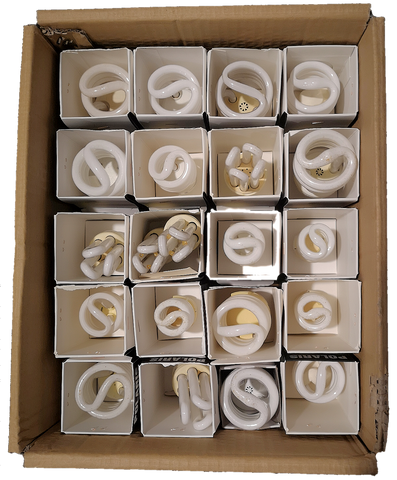
- Have all people and pets leave the room.
- Shutting off any air conditioning or vents.
- Airing out the room by opening doors and windows.
- Not vacuuming.
- Sealing the broken pieces in a glass jar with a metal lid.
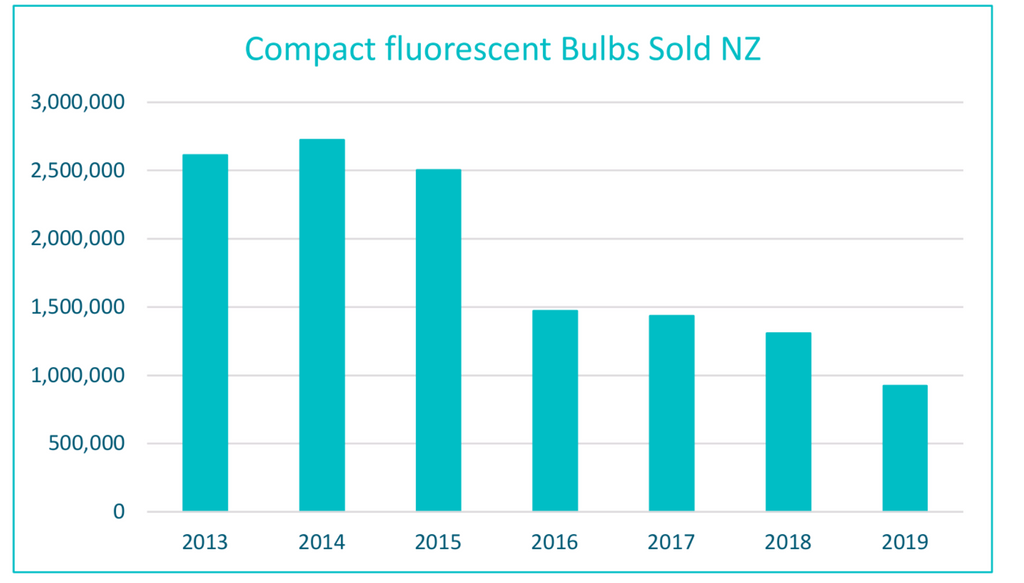
Now, if that’s the process when only one bulb breaks, it makes you wonder what has happened with the 13 million that were sold between 2013 and 2019 in NZ alone… 😬
Pretty scary stuff. So, after a bit of research and some savvy negotiations, here are the basics from what I can gather…
LOW DOWN ON LIGHT BULBS
The Hard and Fast Basics:
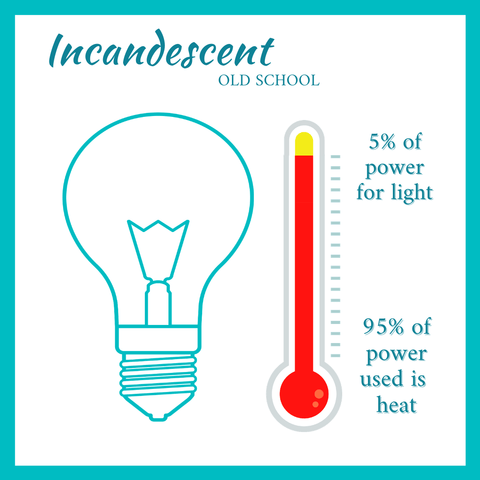
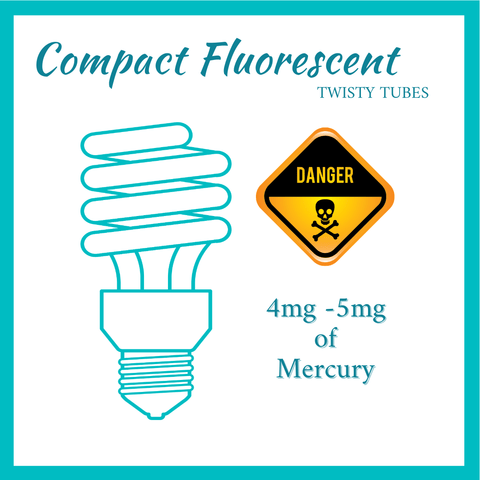
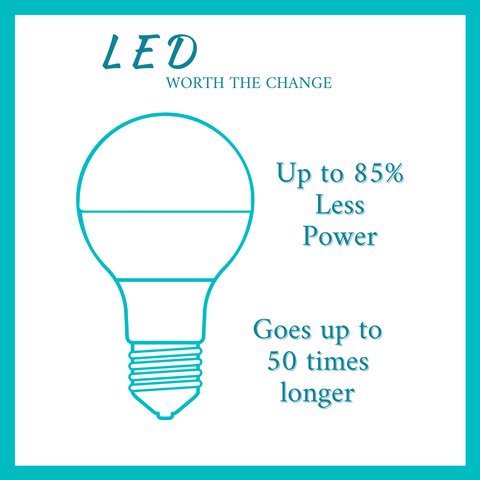
The What's, Why's and How's:
INCANDESCENT BULBS:
- Old-school.
- Invented by Edison in 1879.
- Creates light by heating up the coil.
- 95% of energy goes toward heat.
- Only 5% of energy goes toward creating the light!
- Lifespan of 1000 hours.
- Requires between 40w and 100w of power to light a standard room.
HALOGEN INCANDESCENT BULBS:
- Basically, an incandescent bulb but with halogen gas inside it to extend usage to between 2000 and 4000 hours.
- No change in energy use.
FLUORESCENT BULBS:
- Gas-filled tube or bulb.
- Uses positive and negative charges to cause electrodes to bump into mercury atoms, creating a crash flash.
- Each standard bulb contains 4mg - 5mg of mercury.
- Mercury is a heavy metal that is toxic to humans and that can cause serious brain, liver, kidney, and nervous system damage.
- Four pages detailing broken fluorescent bulb safety protocol.
- Classified as hazardous waste with limited and expensive CFL disposal around the country.
- Produces dirty energy.
- Lifespan of 6000 hours.
- Requires 9w - 20w of power to light a standard room.
LED BULBS:
- Each bulb uses up to 85% less power.
- A light used for 3-4 hours per day can save you around $2.50 a month.
- LED stands for “Light Emitting Diode.”
- Requires 9w - 12w of power to light a standard room.
- Uses a positive and negative charge to move electrons to give off light, similar to a fluorescent bulb, but uses a small semiconductor instead of toxic mercury.
- Light is directional so less wasted space gets lit up.
- Lifespan average of 30,000 hours.
- Lifespan can be between 15,000 - 50,000 depending on factors like more heat in downlight fittings, etc.
BRIGHTNESS = LUMENS
In the past, all 60-watt bulbs produced a similar amount of light, so measuring the brightness this way worked fine. But now an LED bulb requires only 7 watts to light up the same room, so using power consumption as an indicator is no longer applicable.
However, just as the difference between a 60-watt bulb and a 100-watt bulb was not life or death, the difference between an 800-lumen bulb and a 1600-lumen bulb isn't as dramatic as one might think.
|
60 watt
|
6 watt
|
|
75 watt
|
7.5 watt
|
|
100 watt
|
10 watt
|
|
120 watt
|
12 watt
|
COLOUR = K (kelvin)
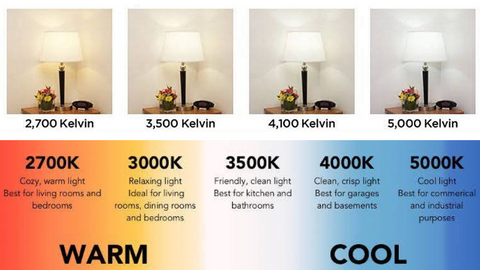 Colour refers to how soft/orange or how bright/blue the glow is.
Colour refers to how soft/orange or how bright/blue the glow is.
Points to consider:
- It’s your personal preference. For example, I prefer a warmer/oranger light, similar to a candle. However, some people prefer a cooler or bluer light.
- Consider the room where the light will be shining. For example, kitchens would generally be a brighter white, using the more crisp, clear sharpness of cool light. Meanwhile, a side lamp or bedroom light may be more suited to a softer, warmer, amber tone.
- Lastly, colour is important when it comes to our ability to wind down, especially for those suffering from lack of sleep or insomnia. This is because colour accounts for how much blue (UV) light is emitted.
Our bodies do this really cool thing: They switch between the production of cortisol (adrenalin) and melatonin and vice versa depending on the level of sunlight around them. Blue light in brighter light bulbs can affect this natural process, making it harder to fall asleep.
The blue light in items such as TVs and phones can also affect your natural sleep process. However, this problem can be easily solved by simply turning on a blue light filter. Those who don't have a blue light filter built in can easily download programs like f.lux blue light screen filter, which is free. You simply set it to where you are in the world and it will remove the blue light at sunset, then ease it back on at sunrise. This is also great for eye strain.
LIGHT FITTINGS
This is simply the bulb connection. Most homes will run a standard Bayonet (E27) or a screw in (E22).
But, of course, there are myriad other fittings for all types of connections, so I'll just leave this little pic here.
So is it worth replacing your bulbs? Yes!
- If you have the original incandescent bulbs and use them 3 - 4 hours per day, replacing this with one LED Bulb could save you up to $2.50 per month per bulb.
- If you have a CFL twisting tube bulb then it is worth the comfort of knowing there is not a hazardous toxic ball hanging smack band in the middle of each of your family rooms.
SAY WHAAAA? Yup! This simple but effective change means that anyone and everyone can take an action that instantly affects home safety, savings, and carbon emissions. We have secured a large (but limited) supply of LED bulbs and we are offering them to you at crazy prices because we want them in your home ASAP!
Let's do this 10,000 LED Bulbs NZ!
Up to 568,189 kg less carbon emissions!
Up to $262,080.00 less spent on power!
*Over a 12 month period, 4 hours per day. Based on 10,000 LED bulbs replacing 10,000 incandescent 80 watt bulbs
1 Methylmercury Exposure and Health Effects Young-Seoub Hong, Yu-Mi Kim, Kyung-Eun Lee J Prev Med Public Health. 2012 Nov; 45(6): 353–363. Published online 2012 Nov 29. doi: 10.3961/jpmph.2012.45.6.353PMCID: PMC3514465
]]>Combine that with the overall rise in plastic production with 1950 producing around 2 million tons of plastic per year, compared to 2015 with 381 million tons of plastic produced. A pretty hefty increase and just a tad concerning to think if this is what is out there now, add that to the increase in production, it doesn't take much to imagine what is to come if we don't change our consumption habits. Plastic Free July is a good reminder, encouraging both individuals and businesses to be mindful of plastic consumption.
Indeed we do all know the hazards of plastic by now, we know about plastic bags, plastic bottles, single use lunch bags and wraps. However, one of the main biggest causes of pollution is one you may not even know exists. Most will never see the scary and exorbitant amounts of hidden pollution within supply chains and stores.
So this Plastic Free July we are begging you all to use, share and scream these 3 tiny words from the rooftops MINIMAL PACKAGING PLEASE.
Online Shopping Growth
We can't deny the advantages that online shopping provided over recent times, with no contact and no leaving the house. So it wasn’t surprising to see the digital drive caused by covid-19. With many resorting to ecommerce for the first time and discovering the advantages and convenience online shopping has to offer.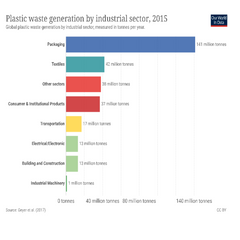
Many reports suggesting that e-commerce will reach over $4.5 trillion by 2021, a 246% increase within the past six years. Industries are adjusting to new technologies to meet consumers growing digital demand, as will the enormous flow of excess bubble wrap and other packaging waste that is discarded throughout the supply chain.
But does the environmental impact have to grow as more people shop online?
One of the great advantages with online sales; the products are going directly to you, the consumer!
This is so powerful as it means that you are in charge, you call the shots, so you can choose to add three simple words that will make a huge difference #minimalpackagingplease! Pretty easy right?
Packaging Paralysis
I still remember our first shipments arriving for Intentionally Sustainable, we had done our homework, spent uncountable hours, days, weeks, months clawing through piles of certifications, negotiating with manufacturers, costumes and the rest but the boxes were finally here. It was so exciting, I could barely wait until they were off loaded, only to rip into them and be absolutely heartbroken. I couldn't believe it, all of our beautiful ‘eco’ items were cloaked in layers upon layers of unnecessary plastic wraps and bags, it was hideous!
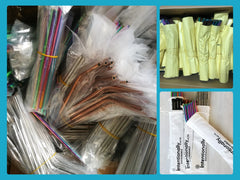 Thus marking the beginning of my journey into the product packaging abyss. It was admitidy something I had not accounted for, in all of the planning and all of the research and everything else not once I did think that I would spend all of my hours in a typhoon of packaging discussions and debates. I could have sworn someone was pranking me, cutlery was arriving with each piece inside the case bagged individually, then the case itself in a plastic bag. Stainless Steel Straws all individually bagged, I am glad it was only that first order. I contacted hundreds of suppliers and a grand total of ‘zero’ of them had alternatives, it was insane.
Thus marking the beginning of my journey into the product packaging abyss. It was admitidy something I had not accounted for, in all of the planning and all of the research and everything else not once I did think that I would spend all of my hours in a typhoon of packaging discussions and debates. I could have sworn someone was pranking me, cutlery was arriving with each piece inside the case bagged individually, then the case itself in a plastic bag. Stainless Steel Straws all individually bagged, I am glad it was only that first order. I contacted hundreds of suppliers and a grand total of ‘zero’ of them had alternatives, it was insane.
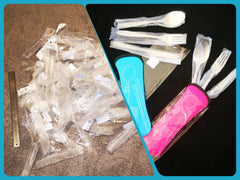 As a company we knew we could not but this all in only to remove a sea of plastic so we could send a pretty little eco product to you, instead ordering in bulk and specifically requesting items are sent without packaging. We would then individually package each item ourselves before it is ready to be ordered and eco-shipped to you, hence maintaining our ethically and intentionally sustainable albeit an exchange for any form of life we may have previously had.
As a company we knew we could not but this all in only to remove a sea of plastic so we could send a pretty little eco product to you, instead ordering in bulk and specifically requesting items are sent without packaging. We would then individually package each item ourselves before it is ready to be ordered and eco-shipped to you, hence maintaining our ethically and intentionally sustainable albeit an exchange for any form of life we may have previously had.
The good news is that more companies are adopting alternatives to plastic packaging in response to consumers becoming more aware of plastic packaging pollution and driving more eco-friendly solutions like adding a note to each order requesting #minimalpackagingplease.
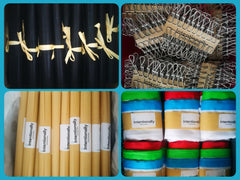
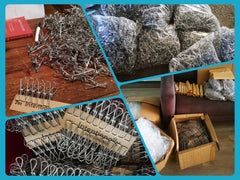
Plastic Free July and The Impact of Individuals
Plastic Free July is a great way to realize how much plastic we all waste on a casual basis. More people will realize how easily they can survive without plastic in their daily lives.
This Plastic Free July we are encouraging everyone to Take The Challenge and remove one disposable item from their daily life as a great way to reduce plastic consumption and disposable waste.
It is only fair to note that whilst every step counts, simply exchanging the one item for use of other materials without addressing overall consumption is not enough to reduce the environmental toll.
Use what you have: a simple glass jar represents a myriad of opportunities. Use to store food, take soup to work, shake up your fav drink, store sugar away from ants, store buttons and other fiddlely nic nacks, freeze leftovers (leaving a ¼ gap at the top and not going straight from or to heat, and loads more.
Buy less, choose well, make it last....and feel free to share any of the images below with your family and friends so everybody requests MINIMAL PACKAGING….please x
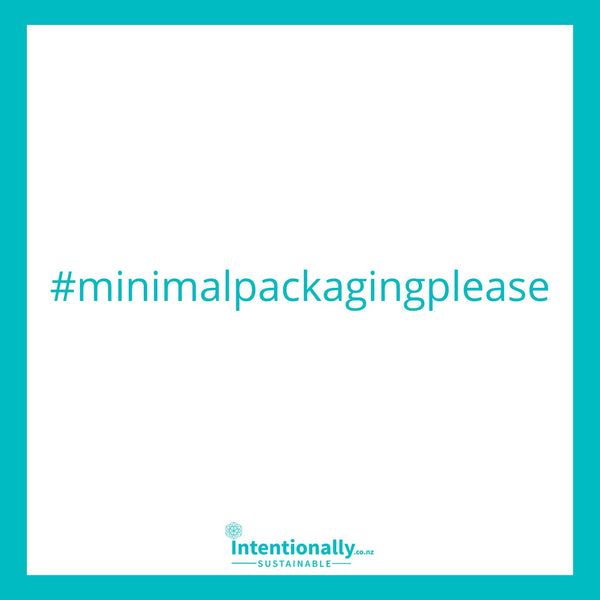

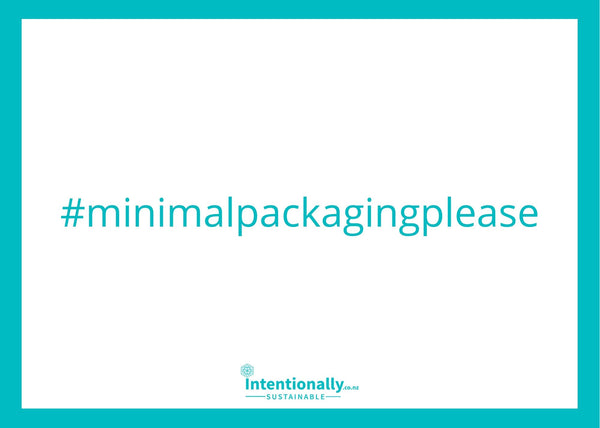
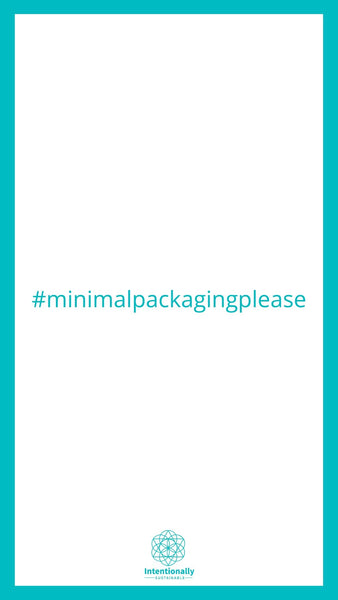
]]>
So why not use this time to regroup, rethink, readjust and realign our focus?
]]>We understand that in the current conditions long-lasting reusable items make more sense than ever, so we are happy to be able to safely continue to provide these for you.
I also want to want to say a huge thanks to everyone for doing such an awesome job at protecting their bubble. I am very grateful that as a country we acted early as we are all aware that a little time now is going to save us a huge toll on not only our time but our country, our freedom and our humanity.
So yes we do need to stay home and we do need to stay safe, but if boredom (or your family 🤭) is driving you crazy then why not download our productivity planner and use this time to regroup, rethink, readjust and realign our focus?
Simply click on the image for your free download and get cray cray productive in your little cocoon? No tricks, no added links or email addresses required. Just a simple download, no strings attached..
Because let's face it, we all have tons we are planning on doing when we get a ROUND TUIT....🥁
Click image to download PDF
]]>
We are all familiar with the triangular recycling symbol; the arrows are in a mobius loop, they chase each other in a clockwise direction.
We find these symbols printed on everyday packaged products such as ‘to go’ cups at the coffee shop or containers used for carrying left over food.
But… despite all recycling efforts implemented since the 1950s only 9% of all plastic has actually been recycled (Gayer, Jambeck & Law, 2017) thus leaving 91% of plastic ending up in landfills, oceans or being burnt.
Are you aware that as of 2016, about 335 million metric tonnes of plastic waste was produced and that single use plastics accounted for almost half of all plastic production annually? (Earth Day Network, 2018)
I don't know about you but this is not the outcome that I imagine when I see this famous symbol!
Here are a few tips and some simple actions that I feel are really simple to implement and will have an instant effect in any home:
1. Realise you can make a difference and change your mindset
Being environmentally aware demands that you acknowledge the impacts that your lifestyle choices have on the environment. Have you really considered your carbon footprint? Do you know what, where and how much of your consumption actually impacts the environment?
There are tools available online to help you calculate your individual impact, thus helping you mitigate the negative impacts to the environment. Such tools include WWF Ecological Footprint Calculator and the carbonfootprint.com calculator to estimate the footprint of what you eat and drink - these tools help you understand your impact to the environment and assist in the changing of your disposable mindset to living a more environmentally conscious life. (It only takes a minute to do this :-)
2. Reducing unnecessary waste
The goal is to minimize waste volume, reduce reliance on landfills and improve human wellbeing. Reducing the production of waste can be achieved by minimizing consumption patterns.
- Put up a bold visible sign stating No Junk Mail - check out Letterboxer for a No Junk Mail sticker to be sent FREE of charge. and loads more information on their Trees Not Ads and will help prevent heaps of waste produced from mostly unread junk mail and proactively contribute to saving the environment.
- Phone books are still automatically delivered but so many are never used - is this the case in your home? If so then it is a very simple save, Yellow have a quick and simple opt out option that takes less than a minute and saves years of that phone book being printed just for you.
3. Be aware of your routine and rather than throwing away an item, switch to reusable products and adapt new waste reduction habits such as:
- Bamboo or Stainless Steel Straws
- Reusable Cotton Make Up Removers
- Donate or Recycle your old Phone
- Use Cotton Cloths instead of Baby Wipes
- Insert Compostable Bin Liners
- Cotton Hankies instead of Tissues
- Reusable Mesh Produce Bags and Carry Bags
- Beeswax food wraps and Silicone Food Covers instead of Cling or Glad Wrap
- Reusable Sandwich and Snack Pack Bags
- Reusable Ziplock Food Pouches
- Reusable Bread Bags
- Bamboo Toothbrush
4. Get your family, friends an flatmates on board
Living sustainably is a collective responsibility and it requires teamwork from every member of your family. You being a good role model is the obvious way to getting all your family onboard and becoming earth friendly. Ask yourself how many gifts do we give family members and friends every year? Imagine if you brought only sustainable gifts? Like Bamboo Flasks! Not only would you reduce the impact on the environment but you could also be responsible for triggering a change in so many peoples habits going forward…. I call this a gentle nudge haha.
Create new habits at home such as purchasing reusable sandwich and snack bag sets for your children to carry to school every day. This imparts them to pick up the habit and grow with it, making them more and more environmentally conscious. Who knows? Maybe other kids from school can learn from them and again you are triggering a change throughout society.
5. Give it a go - Intentionally set a challenge
- Sponsor a tree
- Start using Mouthwash tablets and avoid the plastic bottle
- Place Foldable Travel Spork in the car, your handbag, school bags and say no to plastic offers from food outlets
- Get a Menstrual Cup
- Subscribe to a Toy Library for the Kids
- Using Newspaper for all your gift wrapping
- Use your coffee grounds as a natural cleaning scrub
- Carry your own flask to work - why bother with the hassle and inconvenience of waiting in lines and paying ridiculous prices when you can save your cash and get your coffee exactly how you like it every time - you can take a bamboo flask or french press with you wherever you go (available on our website)
6. Think and Do Sustainability
Before purchasing anything think about their short and long term effects to you and your environment. For instance consider if its more economical to buy a single use bag or silicone ziplock bag? Which is more durable and less harmful to the environment. Gauge the cost benefits analysis before making the purchase.
Do your research and be the change.
Live with intention - it will go a long way in saving our environment.
]]>
Can you believe that statement was released as part of the initiative to drive consumers away from paper bags and towards the 'reusable' plastic bag?
Intentionally Sustainable
One of the reasons I started Intentionally Sustainable was because I kept hearing statements like "humans are so disgusting," or "people are so lazy, they just don't care."
When I thought about my own past use of disposable plastic, I realized that at the time I simply didn't know how much damage it would cause years down the road. I'm not an ignorant person and I'm not disgusting, or lazy. How could I not have known?
As you can see from this time line, in the beginning, no one knew plastic was so bad for the environment.
1926 - Harrods brought out the first multicolour thermosetting plastic tableware
1938 - The first toothbrush with nylon tufts was manufactured
1946 - Tupperware introduced their now famous airtight lid with a 'burping seal'
1948 - The first 12" vinyl LP record was produced
1958 - LEGO hit the market
1959 - Mattel unveiled the Barbie Doll at the American International Toy Fair
The Late 1950's - Tupperware parties arrived on the scene, directly targeting and empowering bored, lonely housewives, many of whom had stepped up during World War II and were eager for an opportunity to run their own business and contribute to the family income. This new lightweight, sturdy, and 'disposable' product was marketed as an essential part of a good healthy home.
Anyone that has a child fifteen years old or older can tell you that the item being disposable was the best part of the product. Disposable plastic plates, cups, cutlery and anything else you could get your hands on revolutionized children's parties.
No one ever mentioned that they didn't know how to dispose of it, or even that it wasn't actually disposable. Back then it was all about saving trees, so everyone used plastic instead.
1985 - The Society of Plastic Engineers' Regional Conference talked about "New Materials and Profits In Grocery Sacks and Co-Extrusions," and pointed out that plastic bags were less expensive than paper bags. At the time, one thousand plastic bags cost $24, while the same number of paper bags could set retailers back $30.
The Late 1980's and Early 1990's - People were still unsure about the choice between paper and plastic, that is, until they were told about the advantages of the 'reusable plastic bag'.
The Film and Bag Federation, a trade group within the Society of Plastics Industry based in Washington, D.C., said the right choice between paper and plastic bags was clearly plastic.
"Compared to paper grocery bags, plastic grocery bags consume 40% less energy, generate 80% less solid waste, produce 70% fewer atmospheric emissions, and release up to 94% fewer waterborne wastes," according to the federation.
Robert Bateman, President of Roplast Industries, a manufacturer of plastic bags (including reusable ones) in Oroville, California, said the economic advantage of plastic bags over paper bags had become too significant for store owners to ignore. "It costs one cent for a standard plastic grocery sack, whereas a paper bag costs four cents,"he said.
All in all, it sounds like a very convincing pitch. But now we are more informed, have more information at our fingertips, and we know better. We also have access to better choices with sustainable bags. So, let's stay positive knowing that together we can make a change.....
Follow my blog with Bloglovin]]>BPA is a man-made compound that has been around for over a hundred years and can be found in food, toiletries, lining canned foods, plastic packaging household items, sports equipment and more. Its basic job is to strengthen whatever item it is included in. In plastics, it makes them stronger and more resilient – hardening them to the rigours of daily life, hence BPA has been found in drink bottles and food containers.
In a lot of the items listed above the BPA may not have been sealed in properly, resulting in BPA leakage into food and drink. BPA can mimic human hormones, specifically estrogen the main female hormone and act as an endocrine disrupter1. This means it can block that natural signals that float around your body you need for daily health. Research has also noted other impacts on human health. BPA may cause infertility in men and women2,3. It can have negative effects on babies, increasing incidences of hyperactivity, anxiousness and aggressiveness4. BPA has been linked to heart disease5 and type 2 diabetes6, and may raise the likelihood of obesity7.
Consider the impact on the oceans and marine life. BPA has leached from the plastic waste in the ocean and from its use on epoxy plastic paints on boats. Scientists now report that BPA has infiltrated marine life, affecting a vast array of marine life8.
And let’s face another truth about plastic; it is derived from petroleum, the same source as petrol. Not only does plastic not break down, but its source is environmentally questionable. BPA is being removed from some plastics, though it appears other chemicals just as unhealthy for ingesting via leaching are being added.
What can you do about it?
- Steer clear of packaged foods.
- Reduce plastic use (obviously)
- Use glass where possible.
- Microwaving plastic is a no no.
- Start sourcing and using silicone based products.
Silicone is not silicon which is sourced from silica from sand. Silicone is a synthetic product but touted as being more environmentally friendlier than plastics. Firstly it does not contain BPA or similar chemicals, so there is no leaching issue. It can be chilled in a freezer or heated in an oven, giving it a wider kitchen use, and it is more durable than plastics which increases its useful life, decreasing landfill of quickly discarded plastics.
Silicone, once degraded does not appear to adversely affect, water, air, soil or sediment, which plastics and its additives are known to do9.
Intentionally Sustainable is committed to reducing plastic waste. Please check out our website for more information on what we think are great starting solutions.
- https://www.ncbi.nlm.nih.gov/pubmed/22889897
- https://www.ncbi.nlm.nih.gov/pubmed/15947000
- https://www.ncbi.nlm.nih.gov/pubmed/21035116
- https://www.ncbi.nlm.nih.gov/pmc/articles/PMC3208956/
- https://www.ncbi.nlm.nih.gov/pubmed/22363351
- https://www.ncbi.nlm.nih.gov/pubmed/21956417
- https://www.ncbi.nlm.nih.gov/pubmed/15118266
- https://www.sciencedaily.com/releases/2010/03/100323184607.htm
- https://www.silicones.eu/wp-content/uploads/2018/10/silicone-research_an-industry-commitment-1.pdf
Next Blog: Reducing Single Use vs Plastic Free Living
]]>One of the simplest ways to begin is by reducing single-single use items that are purchased by you and your family.
]]>Single-Use Product Pollution
Every single day, people throw away single-use products and contaminate the earth, along with the oceans. Only you can know how much of that pollution is coming from your own doorstep. You might think you're living sustainably because you've stopped using plastic, but the problem isn't just plastic products.
Although single-use item reduction can certainly be attributed to by plastic-free living, it's not just plastic that is overflowing from our landfills and littering our oceans. There are many other single-use items that we throw away every day, most of which can be drastically reduced if we replace them with other long-lasting quality items.
Single-use items are, obviously, items that you only use once. Sit back and think about everything you've done today, and how many single-use items you've discarded. While you're thinking about it, remember that little tin can that the soup you had for lunch came in, or the cigarette butts you recently put out in your ashtray. You might not realize it, but all of those things add up quickly and wreck havoc on the environment.
Recycling Isn't Enough
If you recycle, you probably think you're doing everything you can for our environment. But, recycling will never fix the situation. What we need is reform. We need to find ways to drastically reduce the amount of single-use products that wind up in our landfills, and the only way to do that is to start being conscious of everything we discard day after day.
Try not to get overwhelmed as you think about the coffee you drank this morning and the plastic-lined cup it came in. It's not your fault. It's the fault of the marketing genius who decided that it was a good idea to store food in toxic containers and convinced us that disposable plastic products were the best.
Make A Difference Through Single-Use Product Reduction
While this might sound like a harsh reality, it's actually quite positive. Living completely plastic free is hard to do, and might not be achievable for the average family. But, if you can reduce your use of single-use items, you CAN make a difference. Not only will ditching disposable items for long-lasting quality products help protect the environment, it will also save you money.
Let's face it, going plastic free is difficult and setting unachievable goals could have adverse effects. But, one of the simplest ways to begin truly living sustainably, is by reducing the number of single-use items that are purchased by you or your family. Together we CAN make a difference. I also want to give full credit to anyone who has managed to go completely plastic-free – blumen well done for sure!
]]>


